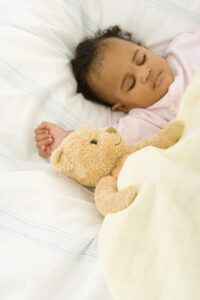Introduction to understanding your baby

Having a baby is an exciting time for a family but it can also be tiring and confusing. Parents often have lots of questions about how they are caring for their baby and if they are doing things ‘right’.
Getting it ‘right’ will be different for different babies. One important thing in understanding your baby is to learn how your baby lets you know what he needs and how he is feeling.
Although your baby cannot speak he will have his own special way of letting you know how best to care for him. From when they are born babies are able to do this but no two babies will do it in the same way.
We hope this booklet will help you to understand your baby so you can enjoy him or her and have fun together.
Self-help information
Babies like to be sociable
Babies like to be sociable
Babies are born with certain behaviours that help them to be sociable and communicate with you. Take time to watch your baby and look at what she does. You will soon learn what she wants and needs though this will take longer with some babies than with others.
Seeing
Babies can see from birth but in the early weeks focus more easily on things about 8 inches away from their faces. They love to watch the human face.

Tip
Hold your baby about 8 inches away from your face. Talk to her and watch what she does. Hold up a bright toy 8 inches away and move it slowly from side to side. Watch her follow it with her eyes or head.
Hearing and listening
Babies can hear everything but they like the sound of the human voice best. Talking to your baby, even though they may not understand the words, can help you bond with your baby. Babies benefit from lots of ‘quiet time’, listening to your voice without background noise (such as TV).
Tip
Stand next to your baby to one side and talk to her. Watch what she does. Now talk to her from the other side. Try playing with your voice high or low and fast or slow.
Smiling
Babies smile from birth but in the early weeks this is usually a reflex or automatic behaviour.
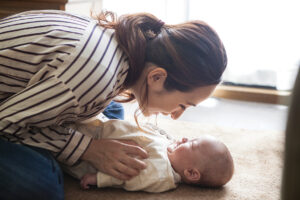
Tip
Watch for your baby’s smile and smile back. Show your pleasure and talk to her. When you have eye contact and she smiles you will know she is smiling at you.
Cuddling
Babies like to cuddle though some like it better than others. Some have certain times when they like cuddles best such as when they are sleepy.
Tip
If you cuddle your baby often from the start you will find out her favourite cuddle and cuddle time. If your baby stiffens when you cuddle her she probably doesn’t want a cuddle at that time.
Moving
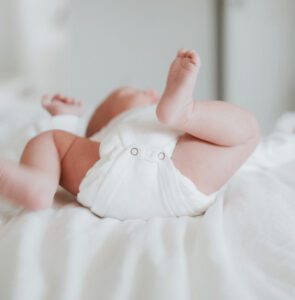
Some babies move their arms and legs a lot and some a little. The movements may be smooth, jerky or little tremors. Some babies have trembly chins! A baby may move more at certain times of day, some when they are cuddled and some when they are left alone.
Tip
Watch your baby and you will learn when she moves the most and what her movements are like.
The traffic light system
The traffic light system
Your baby will communicate with you mainly using body language.
The traffic light system can help you to understand when your baby wants your attention and when he needs a rest.
Using the green for go traffic light system, your baby wants to interact with you when he:
- looks at you
- reaches towards you
- smiles at you
- babbles and talks to you
- has wide and bright eyes.
Using the amber for caution traffic light system, your baby is likely to need a change from what is happening if he:
- looks away
- turns his head away
- yawns
- puts his hands up to his face
- has a dull looking face or eyes.
He may need a change of pace if he:
- becomes more active and restless.
Using the red for stop traffic light system, your baby is letting you know he is distressed and needs a break when he:
- turns away
- cries
- whines or fusses
- squirms or kicks
- arches his back
- pulls away
- vomits.
Different baby states
Different baby states
During the course of each day your baby will move through different levels of sleepiness and wakefulness that are called ‘states’. Learning to read your baby’s states will help you to know how best to respond to her at different times.
Sleep states
Deep sleep

Your baby is in deep sleep when:
- her breathing is steady and regular
- her eyes are closed
- she lies still (though she might sometimes startle, jerk or show sucking movements)
- she is hard to rouse.
Babies do their growing during deep sleep.
Traffic light system says red.
Light sleep
Your baby is in light sleep when:
- his eyes are closed or fluttering. There may be rapid eye movements under the lids.
- he shows some body or face movements
- he may show sucking or smiling movements or make brief fussy or crying sounds
- he is easy to rouse.
Traffic light system says red.
Awake states
Drowsy or dozing
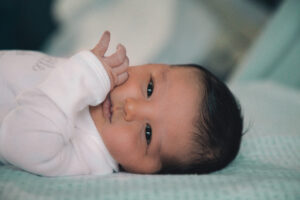
Your baby is in this sleepy state of wakefulness when:
- her eyes are open but glazed or heavy lidded or closed with fluttering eyelids.
- she shows occasional mild startles.
- her body movements are generally smooth.
This is a pre-waking state. She may fall back to sleep again from this state so wait a little before fully waking her. Offering her something to touch or suck may help you to see if she is waking or settling back to sleep.
Traffic light system says amber.
Quiet alert

Your baby is ready for action in this state when:
- he is wide eyed, with a bright face
- he is able to focus on and be interested in a face, voice or moving object
- he shows little body movement
This is the time when he is ready to play, feed or just enjoy your company. This is the best state for your baby to enjoy a massage.
Take your time and be prepared to allow time for him to rest a moment and look away from whatever you are doing with him.
Traffic light system says green.
Active alert

You will know your baby is in this state when:
- she shows lots of activity often with thrashing movements of her arms and legs
- she may fuss
- she may be more sensitive than other times to noise or hunger.
Babies in this state need a change of pace. You need to slow down or change what you are doing. In the night it is likely to indicate the need for a feed.
Traffic light system says amber.
Crying

You will know this state in your baby when:
- he shows lots of body activity
- he grimaces and cries intensely so it is difficult to get through to him.
When your baby cries you need to stop what you are doing with him. Try to calm him using a soothing repetitive approach (see pages 10 and 11 for things to try).
Traffic light system says red.
Rousing and soothing
Rousing and soothing
Small babies will be wide awake, sleepy, fast asleep, and crying lots of times during the course of every 24 hour day. This is quite normal.
For some activities it is better for your baby to be in a certain state. For feeding it is better if your baby is awake. For sleeping it is better if he is relaxed and sleepy first.
Some babies manage to change their state quite well by themselves. Other babies need some help with this. There are some simple ways you can help your baby to be in the state he needs to be in.
Waking a baby
Babies feed better when they are fully awake. You can help your baby to wake up properly. Doing several things close together can work best.
Tip
Try talking to your baby, sitting her up, or undressing her. Put her up on your shoulder, rub her tummy or her cheek.
Calming a baby
Some babies calm themselves down without help from anyone. If your baby is fretful or unsettled try to let him have time to calm and settle himself before you do anything. If he can’t manage by himself there are things you can do to help.
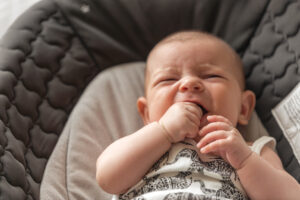
Tip
Let him suck on his fingers or hands if he wants to. Think about changing his position.
Soothing a baby
Soothing a tired and fussy baby isn’t easy but there are things you can do to help. Doing one thing over and over is best for soothing rather than doing a lot of different things. If what you are doing isn’t working after a while try something else but give that a while before you change again.
Tip
Try holding your baby close and rocking, talking or singing softly to her. Try stroking her back or head. Use a baby carrier so she feels close to you. Take her for a walk or a ride in a pram or car.
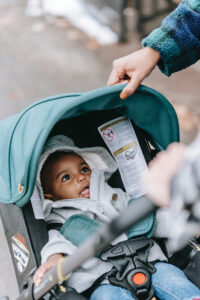
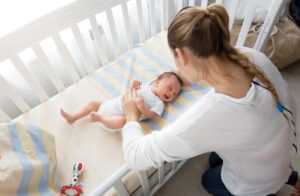
Crying babies
Crying babies

All babies cry as it is the main way they communicate and tell you what they need. They may cry when they are tired, hungry, cold, hot, sick, bored, scared or lonely. In time you are likely to become more familiar with your baby’s cries and understand what different cries are telling you.
Some babies cry more than others and we are not sure why this is. Crying can be very hard for parents and carers especially when it happens a lot. Try the methods for soothing suggested on the previous page.
It is important to remember that long periods of crying may mean your baby is sick or in pain. If this happens call your doctor (or 111) to make sure nothing serious is wrong. If you’re struggling to cope with your baby’s crying and feeling stressed or overwhelmed you could:
- take some ‘time out’ for you. Place him somewhere safe (like his cot) and walk away. Check him at least every 2 to 3 minutes while you are calming yourself to let him know you are still there.
- talk to someone you trust about how you are feeling. This could be a professional.
- ask trusted family or friends (ideally someone your baby knows) to care for your baby for a short while to give you some space.
Sweetly sleep
Sweetly sleep
How to help your baby into a sleep routine
After the first few months of a baby’s life it is a good idea to start a ‘bedtime routine’.
Once upon a time…
Babies need to learn sleep routines. It is not something they are born with. Some learn the skills more easily than others but all babies can learn.

This little piggy…
From birth babies try to soothe and comfort themselves, they may like to suck their fingers, thumbs or hands. Try to make sure that your baby can get her hands to her mouth whenever she is tired or fretful. If baby’s nails are kept short she won’t need scratch mitts on her hands when she is indoors.
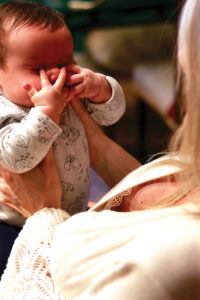
Hush little baby don’t you cry…
All babies cry and it is very normal (see crying babies section). With very young babies it is best to avoid leaving them to cry for long periods in their cot or pram. If they know you are nearby when they cry they may be comforted without being picked up at all. Talking to your baby and patting or stroking her may help her to settle back off to sleep again if she has just woken from a period of light sleep.
Wee Willie Winkie runs through the town. Upstairs downstairs in his nightgown…
After the first months of a baby’s life it is a good idea to start a bedtime routine. This helps your baby to learn the difference between night time sleeping and day time naps. You may want to give your baby a bath, put his night clothes on, tell him a story (or sing him a song), and give him a drink.
This type of routine can be started with babies from around 3 to 5 months of age and continues throughout childhood. Having a routine helps your child to be prepared for bedtime and sleeping and should reduce battles over bedtime as he gets older.
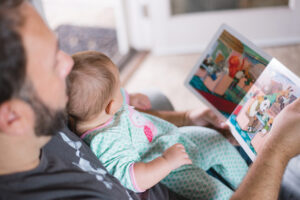
Goodnight sleep tight…
The safest place for your baby to sleep for the first six months is in a crib or cot in a room with you.
It is best to put her to bed when she is sleepy but not fully asleep (after her bedtime routine!) so that she can learn to actually fall to sleep by herself.
If she can learn to do this at bedtime she is much less likely to need you to help her settle back to sleep when she has a wakeful phase during the night. This means everyone has a better night’s sleep. HOORAY!
All bound for morning town…
Some babies will wake up very early even after a good night’s sleep. There is not a lot you can do about this but it is a lot easier to cope with if you have had a reasonable night’s sleep yourself. When your child is older there are some things you can try to help with early waking but with tiny babies they will wake when they need a feed which may be early!
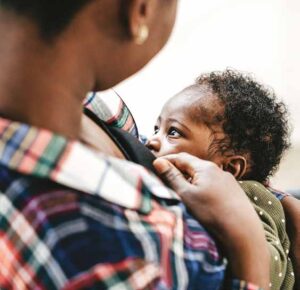
What did I dream?
What did I dream?
Tips for training good sleepers
- Make sure your baby can get his fingers and thumbs to his mouth so he can comfort himself.
- Try not to leave small babies to cry for long periods.
- It is not always necessary to remove a baby from the cot to resettle them.
- Think about a bedtime routine from early in your child’s life.
- Put babies to bed while they are sleepy but awake.
